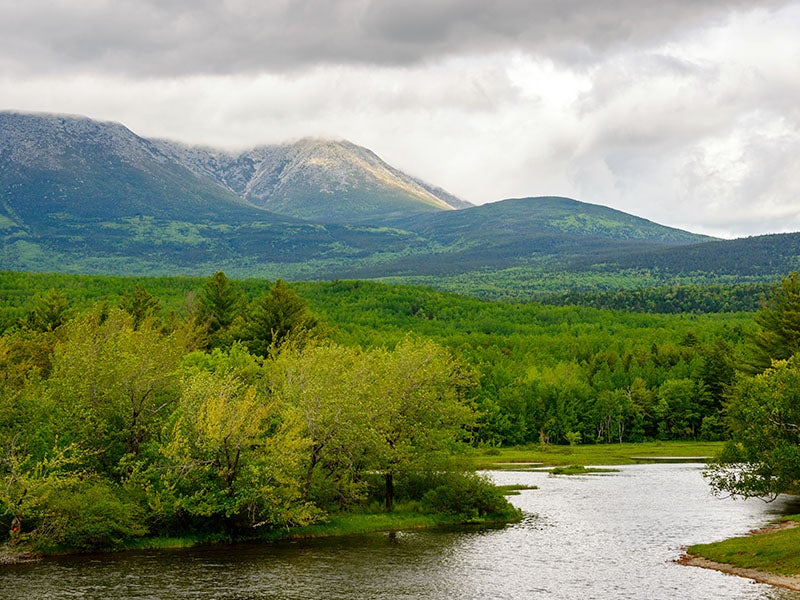Saving Northern Maine’s Economic Gem
: Local business owner Matthew Polstein is fighting the threatened repeal of the Katahdin Woods and Waters National Monument because the new monument has already ramped up tourism and bolstered the regional economy.

This page was published 8 years ago. Find the latest on Earthjustice’s work.
Deep in the heart of northern Maine, the wild landscape of Katahdin Woods and Waters National Monument offers an escape for hikers, kayakers and thrill-seeking white water rafters. It has also been an economic boon to Maine’s Penobscot County. Since former President Obama designated Katahdin Woods and Waters as a monument in 2016, the new status has significantly increased tourism and bolstered local business. But all is not well in Penobscot County. President Trump’s April executive order to review—and potentially repeal or reduce—all national monuments created between 1996 and 2017 seriously threatens northern Maine’s economic gem.
Local business owner Matthew Polstein has seen the monument’s benefits firsthand. An avid outdoorsman, Maine native and owner of the New England Outdoor Center, Twin Pine Camps and River Drivers Restaurant in the nearby town of Millinocket, Polstein was a key player in the monument’s initial designation. He has continued to advocate for the monument by meeting with Interior Secretary Zinke at the local chamber of commerce and traveling to Washington, D.C., to speak with Maine’s congressional delegation.
I spoke with Polstein to find out why he’s fighting to protect Katahdin Woods and Waters National Monument.
Caeleigh MacNeil: How do people in the Katahdin area, especially business owners, feel about the national monument? Is there strong support for keeping the designation in place?
Matthew Polstein: Absolutely. The chamber of commerce was almost unanimously for it, prior to the designation. And plenty of people who weren’t supporters prior to the designation have since become supporters because they’ve seen aspects of the economy improve, they’ve seen people make investments and they’ve seen people show a greater interest in our town. I think they’ve also seen the community come together around this issue. People here are united in support of the monument.
CM: What changes did you observe in your business, and other local businesses, after Katahdin was designated?
MP: In the fall of last year, my restaurant saw a 33 percent growth in business, much of that driven by couples coming to our area to see what the new monument was all about. In [my] lodging business, bookings for May and June of this year increased by more than 60 percent from our three-year average. In response to increased traffic in the area, we’re also planning to open up a store downtown that will sell locally-inspired goods.
“In the fall of last year, my restaurant saw a 33 percent growth in business, much of that driven by couples coming to our area to see what the new monument was all about.”
The businesses in downtown Millinocket all saw a notable uptick in sales and traffic as well. The real estate market has improved, and new businesses are being built—for example, the Knife Edge Trading Post and Pamola Motor Lodge opened in Millinocket this spring. Our main street was busier, and the new park service offices in Millinocket and nearby Patten logged hundreds of visitors in the first week they were open. Those were people who probably wouldn’t have come to the area if the monument hadn’t been designated.
CM: So do you think the designation brings a lot more publicity to the area?
MP: Absolutely. The national brand, or really the global brand, of the National Parks Service, is recognized as a signature of quality. So when you get added to that list, it gets people’s attention.
CM: Why is the Katahdin area special? What draws people there?
MP: A number of things. The monument offers amazing views of Mount Katahdin, a truly iconic peak. The area around it is about 400 or 500 feet above sea level, and the mountain rises up to more than 5,200 feet. It’s the same kind of drama that you see looking at some 10,000-foot peaks out west. This is made even more dramatic by the fact that it’s surrounded by a massive contiguous green forest; part of the 10 million acre working forest— [a privately owned area managed for forest products]—that this area is known for.
“It’s a dramatic wilderness trip. You feel like you’re in the middle of nowhere, which you are.”
We also have a bunch of really great rivers here. There’s a world-class white water area on the west branch of the Penobscot River that runs all summer long. There’s a world-class salmon fishery on that river as well, and then a tremendous canoe trip [section] on the east branch of the Penobscot River.
CM: Do you have a favorite nature spot in the area?
MP: I like the east branch of the Penobscot River, which runs through different pieces of the monument. At this point, it’s seldom used, and you can stay on it for days and see no one else. But you do see moose, you see a lot of bald eagles, geese, deer and otters. There’s an amazing diversity of wildlife, changing scenery and some challenging whitewater—it’s a dramatic wilderness trip. You feel like you’re in the middle of nowhere, which you are.